How To Track Director Buying And Selling
You can track Director buying and selling every day on the Market Index website - CLICK HERE - this gives you a daily list of directors transactions although you can click through on each code to see the history of directors transactions in any stock, or you can simply search a particular stock code at the top of the page. A very useful website because this is a manual process opening PDF documents of director’s transactions every day and recording them. This website also provides a lot of other useful information like recent announcements, dividends and other factual stuff.
Although 90% of the entries are to do with directors exercising or being given options over stock (perhaps as part of their bonus structure or salary package) and can be ignored, you want to look for genuine buying on market. The website notes whether it is an on-market trade or a share issue
.png)
.png) Cadence Capital (ASX: CDM) – Another Listed Investment Company run by Karl Seigling:
Cadence Capital (ASX: CDM) – Another Listed Investment Company run by Karl Seigling:
.png)
.png) But buying aside the much more interesting observations are when directors sell stocks. I see in their a director of K2 Asset Management (ASX: KAM) selling six million shares in KAM for $300,000 this week, they were worth $6,600,000 ten years ago. Always something interesting on that list.
But buying aside the much more interesting observations are when directors sell stocks. I see in their a director of K2 Asset Management (ASX: KAM) selling six million shares in KAM for $300,000 this week, they were worth $6,600,000 ten years ago. Always something interesting on that list.
.png) Kogan (ASX: KGN) - And here's a topical one - yet to be updated for yesterdays $163m sales:
Kogan (ASX: KGN) - And here's a topical one - yet to be updated for yesterdays $163m sales:
.png)
.png)
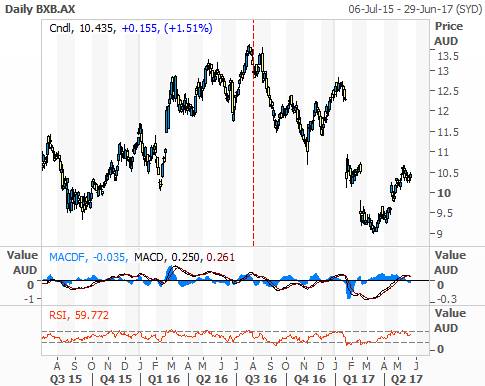 Another director of Healthscope (ASX: HSO) sold 1.4m shares worth $4.27m on 31/8/16 at 305c just before the share price did this:
Another director of Healthscope (ASX: HSO) sold 1.4m shares worth $4.27m on 31/8/16 at 305c just before the share price did this:
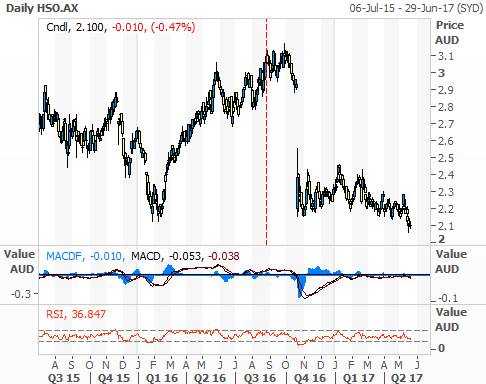 Then we had a couple of Directors of Aconex (ASX: ACX) who between them sold $5m worth of stock in August and September 2016 prior to this:
Then we had a couple of Directors of Aconex (ASX: ACX) who between them sold $5m worth of stock in August and September 2016 prior to this:
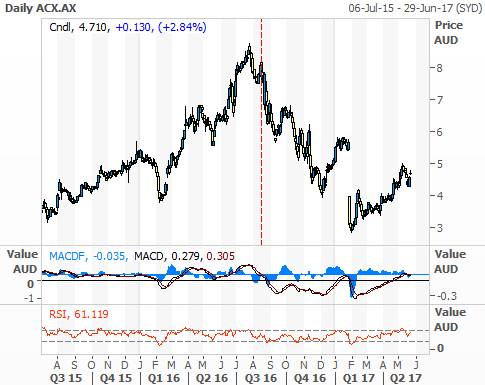 Then there were three directors of Vocus (ASX: VOC) who sold, one sold $26.6m worth of stock on 24/816, one sold $4.3m worth of stock on 24/8/16 and another sold $9.8m worth of stock on 25/8/16.
Then there were three directors of Vocus (ASX: VOC) who sold, one sold $26.6m worth of stock on 24/816, one sold $4.3m worth of stock on 24/8/16 and another sold $9.8m worth of stock on 25/8/16.
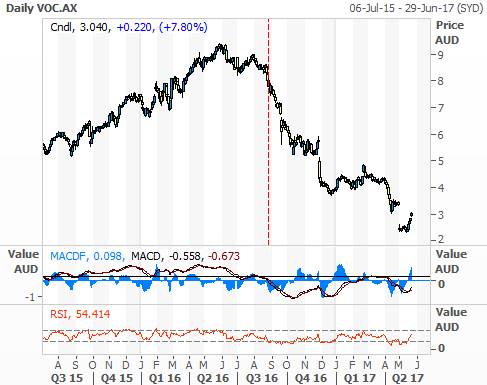 Then there were two directors of Bellamys (ASX: BAL), one the CEO, who sold shares together on 17/3/16 and 26/8/16 (right at the top) worth $8.4m. And the purchase and immediate sale of 832,194 shares bought at 100c (presumably through 100c options) and sold at 670c by the CEO on 9/9/15 netting a profit of $4.7m. In total the CEO has netted around $12.2m through sales.
Then there were two directors of Bellamys (ASX: BAL), one the CEO, who sold shares together on 17/3/16 and 26/8/16 (right at the top) worth $8.4m. And the purchase and immediate sale of 832,194 shares bought at 100c (presumably through 100c options) and sold at 670c by the CEO on 9/9/15 netting a profit of $4.7m. In total the CEO has netted around $12.2m through sales.
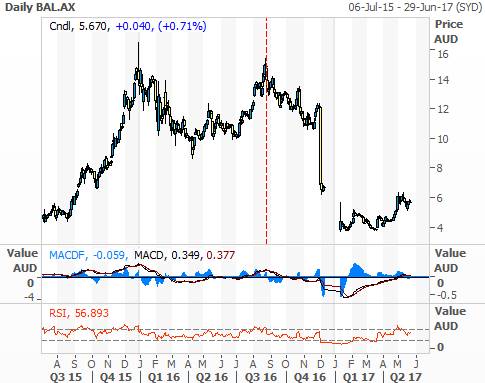 And lets not forget the Sirtex (ASX: SRX) CEO who sold 75,000 shares raising $2.13m on 26/10/16. Not a huge sale but oh so well timed:
And lets not forget the Sirtex (ASX: SRX) CEO who sold 75,000 shares raising $2.13m on 26/10/16. Not a huge sale but oh so well timed:
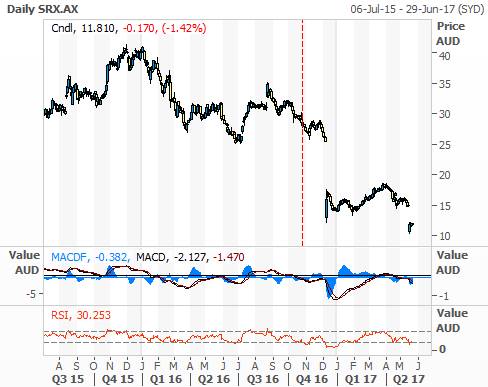
 s. 205G of the Corporations Act 2001 requires every director of a listed company to notify the Australian Securities Exchange (ASX) about any holdings they have, and any changes in their holdings in that listed company, no matter how small. The ASX publishes these notices. Directors are personally liable to do this within five days. It is not the same as the substantial shareholding rules which highlights movements in any shareholdings larger than 5%, these are about Director shareholdings. A breach of s205G is an offence that carries a penalty of up to $1700 or imprisonment for 3 months or both
The net result is that we can all track the director’s shareholdings in any listed company. This of course gives rise to a lot of interesting information which is rather glamourously labelled “Insider Activity” and whilst a lot of Directors are just as bad at timing the buying and selling of their own shares as everyone else, and, most of the time, don’t have any insider information at all, sometimes it is a real eye-opener and a very useful lead indicator. Directors would have to be stupid not to have a better feel for the fortunes of a company than most of us, so it is always worth watching.
Of course, the risk here is that shareholders slavishly respond when they see a Director buying or selling, assuming that they did so because they think the share price is going up when they buy and down when they sell. But there a few things you need to understand.
s. 205G of the Corporations Act 2001 requires every director of a listed company to notify the Australian Securities Exchange (ASX) about any holdings they have, and any changes in their holdings in that listed company, no matter how small. The ASX publishes these notices. Directors are personally liable to do this within five days. It is not the same as the substantial shareholding rules which highlights movements in any shareholdings larger than 5%, these are about Director shareholdings. A breach of s205G is an offence that carries a penalty of up to $1700 or imprisonment for 3 months or both
The net result is that we can all track the director’s shareholdings in any listed company. This of course gives rise to a lot of interesting information which is rather glamourously labelled “Insider Activity” and whilst a lot of Directors are just as bad at timing the buying and selling of their own shares as everyone else, and, most of the time, don’t have any insider information at all, sometimes it is a real eye-opener and a very useful lead indicator. Directors would have to be stupid not to have a better feel for the fortunes of a company than most of us, so it is always worth watching.
Of course, the risk here is that shareholders slavishly respond when they see a Director buying or selling, assuming that they did so because they think the share price is going up when they buy and down when they sell. But there a few things you need to understand.
Other stocks Directors buying on-market recently
Thorney Technologies (ASX: TEK) – Listed Investment Company run by Alex Waislitz:.png)
.png) Cadence Capital (ASX: CDM) – Another Listed Investment Company run by Karl Seigling:
Cadence Capital (ASX: CDM) – Another Listed Investment Company run by Karl Seigling:
.png)
.png) But buying aside the much more interesting observations are when directors sell stocks. I see in their a director of K2 Asset Management (ASX: KAM) selling six million shares in KAM for $300,000 this week, they were worth $6,600,000 ten years ago. Always something interesting on that list.
But buying aside the much more interesting observations are when directors sell stocks. I see in their a director of K2 Asset Management (ASX: KAM) selling six million shares in KAM for $300,000 this week, they were worth $6,600,000 ten years ago. Always something interesting on that list.
.png) Kogan (ASX: KGN) - And here's a topical one - yet to be updated for yesterdays $163m sales:
Kogan (ASX: KGN) - And here's a topical one - yet to be updated for yesterdays $163m sales:
.png)
.png)
SOME ASTONISHING DIRECTOR SALES IN THE PAST
Here are some of the more notable Director sales in the past - they included Bellamys, Sirtex, Aconex, Healthscope, Vocus and Brambles. The charts are a bit old but you really want to see what happened in the short term after the sales and the charts show that. The day of the sale is shown by a red line: A sale of 652,340 shares in Brambles (ASX: BXB) worth $8.4m by one of its directors on 23/8/16. This is the share price immediately afterwards: Another director of Healthscope (ASX: HSO) sold 1.4m shares worth $4.27m on 31/8/16 at 305c just before the share price did this:
Another director of Healthscope (ASX: HSO) sold 1.4m shares worth $4.27m on 31/8/16 at 305c just before the share price did this:
 Then we had a couple of Directors of Aconex (ASX: ACX) who between them sold $5m worth of stock in August and September 2016 prior to this:
Then we had a couple of Directors of Aconex (ASX: ACX) who between them sold $5m worth of stock in August and September 2016 prior to this:
 Then there were three directors of Vocus (ASX: VOC) who sold, one sold $26.6m worth of stock on 24/816, one sold $4.3m worth of stock on 24/8/16 and another sold $9.8m worth of stock on 25/8/16.
Then there were three directors of Vocus (ASX: VOC) who sold, one sold $26.6m worth of stock on 24/816, one sold $4.3m worth of stock on 24/8/16 and another sold $9.8m worth of stock on 25/8/16.
 Then there were two directors of Bellamys (ASX: BAL), one the CEO, who sold shares together on 17/3/16 and 26/8/16 (right at the top) worth $8.4m. And the purchase and immediate sale of 832,194 shares bought at 100c (presumably through 100c options) and sold at 670c by the CEO on 9/9/15 netting a profit of $4.7m. In total the CEO has netted around $12.2m through sales.
Then there were two directors of Bellamys (ASX: BAL), one the CEO, who sold shares together on 17/3/16 and 26/8/16 (right at the top) worth $8.4m. And the purchase and immediate sale of 832,194 shares bought at 100c (presumably through 100c options) and sold at 670c by the CEO on 9/9/15 netting a profit of $4.7m. In total the CEO has netted around $12.2m through sales.
 And lets not forget the Sirtex (ASX: SRX) CEO who sold 75,000 shares raising $2.13m on 26/10/16. Not a huge sale but oh so well timed:
And lets not forget the Sirtex (ASX: SRX) CEO who sold 75,000 shares raising $2.13m on 26/10/16. Not a huge sale but oh so well timed:

2016 was riddled with Insider Activity worth knowing
One fund manager in the AFR article described 2016 as a ‘Banner year for the informational value of insider traders’. The above charts make you want to check Director sales every day, especially in mid-caps, just in case the Directors have decided that the stock market has got out of hand in its enthusiasm for the company compared to its value.Directors are highly sensitive to the share price
For some directors their shareholding in their own company may represent their main asset, their retirement, and they watch it every day. In which case a lot of them are very sensitive to the share price trend and are likely to react before you when it comes to protecting their wealth or their wealth being destroyed. On that basis director sales can actually be a good technical indicator we should mark on the charts. They are after all, more in tune with the share price than anyone else.Shareholders are watching
Director selling is public information. Directors sell in the full glare of their own shareholders. They risk their credibility, so it is a big decision and on that basis a very interesting bit of information. If directors have decided that the stock market has become too enthusiastic about the value of their company, enough to publicly sell, its a statement.Tracking director transactions is a standard check for any fund manager deciding whether to invest in a stock
Particularly in small and mid-cap stocks. They would also want to get their head around who the substantial shareholders are, who has the power, who has the influence and whether the management are free range, able to do what they want, or hostages to some founding family shareholder that can call the shots from the amateur back benches. Important to know. Who owns this company and who runs it. Hopefully, for the sake of investors, they are the same.DIRECTOR SELLING EXPLAINED
 s. 205G of the Corporations Act 2001 requires every director of a listed company to notify the Australian Securities Exchange (ASX) about any holdings they have, and any changes in their holdings in that listed company, no matter how small. The ASX publishes these notices. Directors are personally liable to do this within five days. It is not the same as the substantial shareholding rules which highlights movements in any shareholdings larger than 5%, these are about Director shareholdings. A breach of s205G is an offence that carries a penalty of up to $1700 or imprisonment for 3 months or both
The net result is that we can all track the director’s shareholdings in any listed company. This of course gives rise to a lot of interesting information which is rather glamourously labelled “Insider Activity” and whilst a lot of Directors are just as bad at timing the buying and selling of their own shares as everyone else, and, most of the time, don’t have any insider information at all, sometimes it is a real eye-opener and a very useful lead indicator. Directors would have to be stupid not to have a better feel for the fortunes of a company than most of us, so it is always worth watching.
Of course, the risk here is that shareholders slavishly respond when they see a Director buying or selling, assuming that they did so because they think the share price is going up when they buy and down when they sell. But there a few things you need to understand.
s. 205G of the Corporations Act 2001 requires every director of a listed company to notify the Australian Securities Exchange (ASX) about any holdings they have, and any changes in their holdings in that listed company, no matter how small. The ASX publishes these notices. Directors are personally liable to do this within five days. It is not the same as the substantial shareholding rules which highlights movements in any shareholdings larger than 5%, these are about Director shareholdings. A breach of s205G is an offence that carries a penalty of up to $1700 or imprisonment for 3 months or both
The net result is that we can all track the director’s shareholdings in any listed company. This of course gives rise to a lot of interesting information which is rather glamourously labelled “Insider Activity” and whilst a lot of Directors are just as bad at timing the buying and selling of their own shares as everyone else, and, most of the time, don’t have any insider information at all, sometimes it is a real eye-opener and a very useful lead indicator. Directors would have to be stupid not to have a better feel for the fortunes of a company than most of us, so it is always worth watching.
Of course, the risk here is that shareholders slavishly respond when they see a Director buying or selling, assuming that they did so because they think the share price is going up when they buy and down when they sell. But there a few things you need to understand.
- A lot of directors sell shares to finance something, for personal reasons, not because they think the share price is going down. Shares are often a director’s only liquid asset and they use it like a bank, to pay off the mortgage, pay for a wedding, cover the school fees, or to buy an apartment for the kids. Director sales are not necessarily a judgement on the future direction of the share price.
- When a lot of directors sell or buy at once it is not necessarily a strong statement about the share price. It is often because they have what are called blackout periods when they cannot sell (before results in particular). Most directors only get a few windows during the year when they are allowed to sell or buy under their own corporate rules. One of those is after the results are released but not before. So when results come out and a lot of directors suddenly sell, its simply because they can, not because they have all had the same thought at the same time.
- Don’t jump to conclusions when you see huge sales of shares from directors. Quite often they have had “in the money” options that mature on a particular date. It is a trade they cannot refuse to do even if they cannot afford to do it. If the option is to buy the underlying shares for a price which is well below the current share price they have to do it rather than let the options lapse. But they may not have the money to exercise these options. So what they do is agree with the bank, or the company, to take up the option, take possession of the shares and then sell enough of those shares to pay the call, or sell them all and pay the call. The net result is that it appears as a huge sale when in fact it was just a funding issue.
- When directors buy it is rarely actually an on market purchase. Most of the time directors are getting issued shares in lieu of a performance bonus, a DRP, a share issue, an off-market transfer, a movement from one entity to another, a share purchase plan, as a bonus or through the maturing of options. So don’t just assume they are buyers. Quite a lot of directors, just like us, are salaried, with a mortgage and not asset rich. They could never find a spare $100,000 after tax to buy shares in their own company. So you want to look for director transactions that are ‘on-market’ transactions, bought with cash, because more often than not, an increase in a director holding is going to be an issue of shares not a straight purchase for cash. Of course, when they do buy for cash, it does mean something, and if they only buy a small amount, don’t dismiss it, it often means more, when a poor director buys shares, it is more significant than a rich director topping up.
- Different entities. A director can hold shares in a number of entities. Generally speaking you will see a director shareholding notice for one entity, it doesn’t mean that’s their total shareholding. They may also hold shares in company names, their spouses’ name, their kids name, in a super fund or in a family trust. What you see in the notice might not be the full extent of their interest.
- Then there are the initial director shareholding notices. Always worth a look to see if the new CEO has been given a lot of shares or options to motivate them. Good if they have.
- Then there are director sales. These can be very interesting if they are genuine on-market sales. But more often than not directors only sell when they retire and this is the nest egg, when they leave a company and want to move on or when they need the money. So when a director, or a series of directors sell, especially on-market, this is a very interesting bit of information.